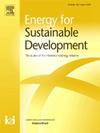Sustainable development study of biomass new energy in rural buildings based on LCA-emergy-carbon footprint and machine learning methods
IF 4.9
2区 工程技术
Q2 ENERGY & FUELS
引用次数: 0
Abstract
This study delves deeply into the impact of the application of biomass new energy in rural buildings on overall sustainability, particularly in terms of energy conservation and emission reduction. The research comprehensively considers the energy value and carbon emissions of biomass energy throughout its entire life cycle, from production to consumption, ensuring the comprehensiveness and accuracy of the assessment. The study employs a random forest model, going through steps such as data preprocessing (cleaning, feature selection, standardization), data splitting (80 % training set, 20 % test set), model training (random sampling, feature selection, decision tree construction), hyperparameter optimization (number of decision trees, maximum depth, number of features), and performance evaluation (mean squared error, coefficient of determination, etc.), to ensure the scientificity and accuracy of the model. Key parameters include the number of decision trees (100-500), maximum depth, and the number of features selected, which are optimized through grid search and random search to enhance the model's predictive ability. The main research findings include: Based on the data from the case study in this paper, at a 95 % confidence level, it is believed that farmers' heating and cooking costs could be reduced by 30 % to 50 % through the use of biomass energy. According to the technological improvements, market conditions, policy changes and other factors in this case, a rural community can reduce about 3000 tons of carbon dioxide emissions annually by replacing 1000 tons of coal with biomass energy, with an error range of 3 % to 6 %. Replacing coal with biomass energy can reduce sulfur dioxide and nitrogen oxide emissions by approximately 90 %. Future research will deepen data analysis, explore the impact of economic activities and energy prices and other factors, and focus on the issue of carbon emissions growth in the long-term operation of biomass energy systems to explore effective emission reduction pathways.
基于lca -能源-碳足迹和机器学习方法的农村建筑生物质新能源可持续发展研究
本研究深入探讨了生物质新能源在农村建筑中的应用对整体可持续性的影响,特别是在节能减排方面。本研究综合考虑了生物质能从生产到消费的整个生命周期的能值和碳排放,保证了评估的全面性和准确性。本研究采用随机森林模型,通过数据预处理(清洗、特征选择、标准化)、数据分割(80%训练集、20%测试集)、模型训练(随机抽样、特征选择、决策树构建)、超参数优化(决策树数量、最大深度、特征数量)、性能评价(均方误差、决定系数等)等步骤,确保模型的科学性和准确性。关键参数包括决策树数(100-500)、最大深度、选择的特征数等,通过网格搜索和随机搜索进行优化,增强模型的预测能力。主要研究结果包括:基于本文案例研究的数据,在95%的置信水平下,认为通过使用生物质能源,农民的取暖和烹饪成本可以降低30%至50%。根据本案例中的技术改进、市场条件、政策变化等因素,一个农村社区用生物质能替代1000吨煤炭,每年可减少3000吨左右的二氧化碳排放,误差范围为3% ~ 6%。用生物质能代替煤炭可以减少约90%的二氧化硫和氮氧化物排放。未来的研究将深化数据分析,探索经济活动和能源价格等因素的影响,重点关注生物质能源系统长期运行中的碳排放增长问题,探索有效的减排路径。
本文章由计算机程序翻译,如有差异,请以英文原文为准。
求助全文
约1分钟内获得全文
求助全文
来源期刊

Energy for Sustainable Development
ENERGY & FUELS-ENERGY & FUELS
CiteScore
8.10
自引率
9.10%
发文量
187
审稿时长
6-12 weeks
期刊介绍:
Published on behalf of the International Energy Initiative, Energy for Sustainable Development is the journal for decision makers, managers, consultants, policy makers, planners and researchers in both government and non-government organizations. It publishes original research and reviews about energy in developing countries, sustainable development, energy resources, technologies, policies and interactions.
 求助内容:
求助内容: 应助结果提醒方式:
应助结果提醒方式:


